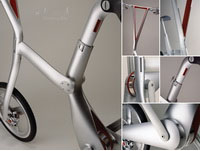
The Taipei Cycle Show kicked off yesterday, and with it the winners of the 2010 International Bicycle Design Awards (IBDC) were announced. Taiwanese designer Hsi Huang took the grand prize for his “Shopping Bike”, which folds to transform into a shopping cart. Eric Stoddard, who had an entry in the competition and will be sharing his thoughts from the show soon, pointed out that, “All 3 of the top awards went to Taiwan designers, a sign of Taiwan’s growing dominance in the cycle industry and Asia’s increasing excellence in design. The Gold-winning Shopping Bike was definitely the standout in terms of concept, execution, and model quality.” You can read more about Huang’s winning entry, and the other winning entries here. I also want to point out that Eric’s AutoVelo concept was given an Excellent Award. Congrats to him for that recognition.
You may remember that Mark Sanders was a keynote speaker at the Taipei Cycle Show last year. This year, he is also speaking, and participating in panel discussions, at the show. His “Imagine’ article (re-titled “How Apple would Launch a bicycle”) was published in the first Taipei Show Daily. You can also see the original version of his article here. As an industrial designer who works on different types of products, I was quite interested to read Mark’s thoughts on the “bicycle as a consumer product.” Though I personally love to ride bikes aimed at the recreational “sporting” market (road, mountain, cyclo-cross, track, etc) I do agree that the industry concentrates way too much on that existing base of core users. Mark makes some great points in his side-by-side comparison of the “consumer product industry” and the “bicycle industry”. Take a minute to read his article and share your thoughts here.

Leave a Reply